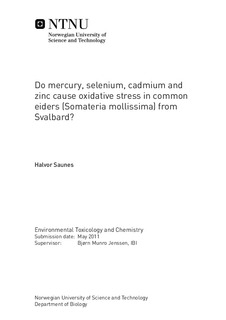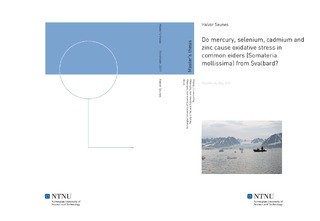| dc.description.abstract | The levels of mercury have shown to increase in the Arctic environment as a cause of human activities. Few studies have examined the antioxidant system as a response to heavy metals in Arctic seabirds. Levels of the elements mercury (Hg), selenium (Se), cadmium (Cd) and zinc (Zn) were analyzed in hepatic tissues of female common eiders (Somateria mollissima) collected in July 2008 and 2009 from Kongsfjorden (KF) and Liefdefjorden (LF), Svalbard. The molar ratio of Hg relative to Se (ratio Hg:Se) was also calculated. The two fjord systems are dominated by inflow of different water masses (Atlantic vs. Arctic), which are suggested to vary in the abundance of contaminants. As an indicator of heavy metal exposure, antioxidants in the defense against reactive oxygen species (ROS) were analyzed. These were total reduced glutathione (tGSH), oxidized glutathione (GSSG) and their ratio (tGSH:GSSG), together with its unique enzymes glutathione reductase (GR) and glutathione peroxidase (GPx). Other proteins quantified included metallothionein (MT) and catalase (CAT). As a measure of oxidative damage the levels of lipid peroxidation (TBARS) were analyzed. Se, ratio Hg:Se, GSSG, ratio tGSH:GSSG, GPx and CAT were found to be significantly different between the locations; however this was only in 2008. No parameter was found significantly different between the fjords in 2009. Differences were mainly thought to be caused by seasonal changes between the locations and years rather than various inflows of Atlantic and Arctic waters in the two fjords. The common eiders seems to be less affected by the examined elements compared to seabirds at higher trophic position, except with respect to Se, which were found in relative high concentrations. In the general linear models (GLM) Hg was a strong predictor of levels of GR and MT. In addition, Se was found to correlate with GPx and Zn correlated strongly with MT. However, the metals revealed fewer relationships with enzyme activity compared to previous studies. The present study suggests that several physiological and ecological factors are more important than element burden in explaining differences in status of the antioxidant defense system. This especially involves the female common eider which goes through a prolonged period of incubation fast. | nb_NO |

